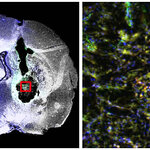Neuroscience

I was listening to a presentation being given by futurist David Houle a few days ago. He began to talk about how technology is changing the way that people communicate and work, particularly with the exponential global growth in cell phone subscribers. As he relayed stats, he discussed implications for how society works. This made me begin to think of something that had been pestering the back of my mind for a while, the implications of the rapid adoption of Facebook.
Recently I read in The Economist, in an article titled Primates on Facebook, about a study that…

Evolutionary theorist Alastair Clarke says eight patterns are the basis of all the humor that has ever been imagined or expressed, regardless of civilization, culture or personal taste.
That's right, if you thought you heard that Seinfeld joke before, it's because it is part of your collective unconscious.
Clarke has stated before that humor is based on the 'surprise' recognition of patterns but now he has gone further and identified the precise nature of the patterns involved, addressing the deceptively simple unit and context relationships at their foundation. His research goes…

A new study says that the human brain lives "on the edge of chaos", at a critical transition point between randomness and order. Theoretical speculation? Well, yeah, but that's the nature of neuroscience.
The researchers say self-organized criticality (where systems spontaneously organize themselves to operate at a critical point between order and randomness), can emerge from complex interactions in many different physical systems, including avalanches, forest fires, earthquakes, and heartbeat rhythms.
According to this study, conducted by a team from the University of Cambridge…

In a study published in the March issue of Cortex, researchers used a brain scanner to record the activity in each stage while people were in the process of drawing faces. The researchers found that the captured visual information is stored as a series of locations or action plans to reach those locations. It is as if the brain remembers key locations and then 'connect the dots' with a straight or curved line to achieve the desired image on the page.
Participants who had no particular expertise as artists were studied using an MRI scanner to measure levels of oxygen in the brain. They viewed…

They say a picture tells a thousand stories, but can it also tell how smart you are? Yes, say UCLA researchers.
In a Journal of Neuroscience study, UCLA neurology professor Paul Thompson and colleagues used a new type of brain-imaging scanner to show that intelligence is strongly influenced by the quality of the brain's axons, or wiring that sends signals throughout the brain. The faster the signaling, the faster the brain processes information. And since the integrity of the brain's wiring is influenced by genes, the genes we inherit play a far greater role in intelligence than…

Synchronized, goal-directed actions are nothing new; that concept is the foundation of civilization. But it goes much deeper than previously realized, according to research in BMC Neuroscience. It isn't just voluntary cooperation that happens, sometimes it is at the unconscious brain level.
A new study shows that when musicians play along together it isn't just their instruments that are working together, it is happening at the brain wave level also. The research details how EEG readouts from pairs of guitarists become more synchronized, a finding with wider…

Want to be fearless? Create an army of super soldiers? A limited test case may be on to something.
A team of Dutch researchers led by Vici-winner Merel Kindt at Universiteit van Amsterdam has successfully reduced the 'fear response' - they weakened fear memories in human volunteers by administering the beta-blocker propranolol. Most interestingly, the fear response does not return.
Can fear be deleted?
Klindt's team says changes can be stored in the emotional memory of people. Before fear memories are stored in the long-term memory, there is a…

Researchers say they have found the first unambiguous evidence that an animal other than humans can make spontaneous plans for future events. The report in Current Biology highlights a decade of observations of a male chimpanzee calmly collecting stones and fashioning concrete discs that he would later use to hurl at zoo visitors.
While researchers have observed many ape behaviors that could involve planning both in the wild and in captivity, it generally hasn't been possible to judge whether they were really meeting a current or future need, he added. For instance, when a chimp breaks a twig…

Effective stem cell treatment for strokes has taken a significant step forward as scientists writing in Biomaterials reveal how they have replaced stroke-damaged brain tissue in rats using neural stem cells.
The work, carried out at the King's College London Institute of Psychiatry and University of Nottingham, shows that by inserting tiny scaffolding with stem cells attached, it is possible to fill a hole left by stroke damage with brand new brain tissue within 7 days.
Neural stem cells exist in the adult nervous system of all mammals, though they can also be derived from more primitive…

Neuroscientists at New York University and Harvard University say they have identified the neural systems involved in forming first impressions of others. The findings may show how we encode social information and then evaluate it in making these initial judgments, according to the study in Nature Neuroscience.
Making sense of others in a social interaction is not easy—each new person we meet may be a source of ambiguous and complex information. However, when encountering someone for the first time, we are often quick to judge whether we like that person or not. In fact, previous…